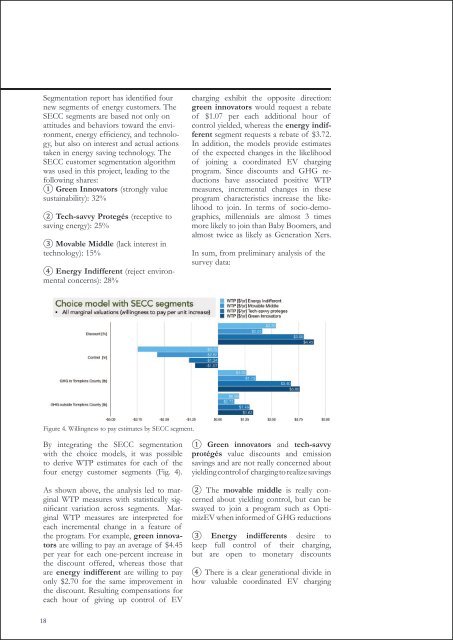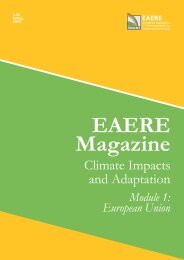EAERE Magazine - n.8 Winter 2020
Create successful ePaper yourself
Turn your PDF publications into a flip-book with our unique Google optimized e-Paper software.
Segmentation report has identified four<br />
new segments of energy customers. The<br />
SECC segments are based not only on<br />
attitudes and behaviors toward the environment,<br />
energy efficiency, and technology,<br />
but also on interest and actual actions<br />
taken in energy saving technology. The<br />
SECC customer segmentation algorithm<br />
was used in this project, leading to the<br />
following shares:<br />
1 Green Innovators (strongly value<br />
sustainability): 32%<br />
2 Tech-savvy Protegés (receptive to<br />
saving energy): 25%<br />
3 Movable Middle (lack interest in<br />
technology): 15%<br />
4 Energy Indifferent (reject environmental<br />
concerns): 28%<br />
charging exhibit the opposite direction:<br />
green innovators would request a rebate<br />
of $1.07 per each additional hour of<br />
control yielded, whereas the energy indifferent<br />
segment requests a rebate of $3.72.<br />
In addition, the models provide estimates<br />
of the expected changes in the likelihood<br />
of joining a coordinated EV charging<br />
program. Since discounts and GHG reductions<br />
have associated positive WTP<br />
measures, incremental changes in these<br />
program characteristics increase the likelihood<br />
to join. In terms of socio-demographics,<br />
millennials are almost 3 times<br />
more likely to join than Baby Boomers, and<br />
almost twice as likely as Generation Xers.<br />
In sum, from preliminary analysis of the<br />
survey data:<br />
Figure 4. Willingness to pay estimates by SECC segment.<br />
By integrating the SECC segmentation<br />
with the choice models, it was possible<br />
to derive WTP estimates for each of the<br />
four energy customer segments (Fig. 4).<br />
As shown above, the analysis led to marginal<br />
WTP measures with statistically significant<br />
variation across segments. Marginal<br />
WTP measures are interpreted for<br />
each incremental change in a feature of<br />
the program. For example, green innovators<br />
are willing to pay an average of $4.45<br />
per year for each one-percent increase in<br />
the discount offered, whereas those that<br />
are energy indifferent are willing to pay<br />
only $2.70 for the same improvement in<br />
the discount. Resulting compensations for<br />
each hour of giving up control of EV<br />
1 Green innovators and tech-savvy<br />
protégés value discounts and emission<br />
savings and are not really concerned about<br />
yielding control of charging to realize savings<br />
2 The movable middle is really concerned<br />
about yielding control, but can be<br />
swayed to join a program such as OptimizEV<br />
when informed of GHG reductions<br />
3 Energy indifferents desire to<br />
keep full control of their charging,<br />
but are open to monetary discounts<br />
4 There is a clear generational divide in<br />
how valuable coordinated EV charging<br />
18













